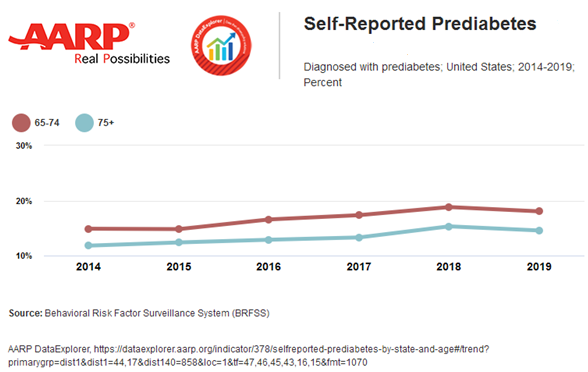AARP Hearing Center
Prediabetes Awareness Increasing but Remains Low Among Older Americans
By Olivia Dean, Beth Carter, Jennifer Peed, December 14, 2020 10:21 AM

Go to AARP’s website to learn more about preventing diabetes and find out if you are at risk for prediabetes.
In 2018, more than 24 million —or nearly half— of American adults age 65 and older were estimated to have prediabetes, putting them at risk of developing type 2 diabetes, a serious and costly disease that can lead to debilitating complications such as heart disease, stroke, kidney disease, and amputations. Type 2 diabetes is one of the most expensive health conditions to manage in the U.S., with an estimated $237 billion spent on direct medical costs linked to diabetes in 2017 alone.
People with prediabetes have higher than normal blood sugar levels but not high enough to be considered type 2 diabetes. They rarely have symptoms, increasing the likelihood that people may have it and not know it. Prediabetes is reversible, but awareness is key – and unfortunately nearly 80 percent of older adults with prediabetes don’t know they have it. Awareness has increased over time but still remains low. The age-adjusted prevalence of prediabetes in adults remains at the same level as it was from 2005 to 2008.
Do More of Those with Prediabetes Know It?
To better understand the level of awareness of prediabetes among older adults with the condition, the AARP Public Policy Institute analyzed data from the Behavioral Risk Factor Surveillance System (BRFSS), an instrument that asks respondents if they’ve been told they have prediabetes by a health professional.
Our analysis of BRFSS data revealed that Americans ages 65 and older who self-reported having prediabetes increased by 22 percent from 2014 to 2019. In 2014, 13.6 percent of adults ages 65 and older reported having prediabetes. That share gradually increased to 17.4 percent in 2018 before falling slightly to 16.6 percent in 2019 (Figure). Adults ages 65-74 were more likely to report having prediabetes than adults ages 75 and older.
These numbers are telling, particularly when considered in combination with findings that the prevalence of prediabetes has not increased. Rather than showing an increase in prediabetes prevalence, these data likely represent an increase in the share of older adults with prediabetes who are aware they have the condition.
Continuing to Build Awareness
While an increase in prediabetes awareness is a positive trend, the data show there is still a lot of work to do. Increasing awareness is the first step to preventing prediabetes from becoming type 2 diabetes and reducing the health care costs associated with the disease. A short online prediabetes risk test can help older adults find out if they might be at risk for the condition. However, a blood test ordered by a health care provider is the only way to know for sure if someone has prediabetes or diabetes. On the provider side, it is crucial for clinicians to identify those with prediabetes and refer them to appropriate interventions so prediabetes does not develop into type 2 diabetes.
Effective interventions are available. Certain lifestyle changes, such as increasing physical activity and improving diet, may prevent prediabetes from developing into type 2 diabetes. Resources are available to help people with prediabetes make healthy lifestyle changes. The Centers for Disease Control and Prevention (CDC) National Diabetes Prevention Program (DPP) teaches enrollees how to adopt healthy lifestyle changes. The program is offered at YMCAs, community centers, churches, and hospitals across the country.

*See data on prediabetes and other topics on AARP DataExplorer, an interactive website developed by the AARP Public Policy Institute. DataExplorer provides easy access to data on a wide array of issues relevant to the 50+ population, such as health, demographics, financial security, long-term services and supports, housing, and transportation.*
**To find a Diabetes Prevention Program (DPP) near you, enter your zip code into the CDC program finder tool. In addition, Medicare now reimburses qualifying health care practitioners who provide DPP to their patients. To find a Medicare-covered DPP class near you, enter your zip code here.**


































































